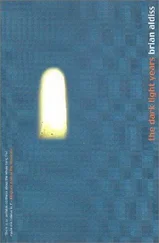The light brightens. Music, and the sight of a savage tropical landscape. The peaks of mountains covered with rain forest stand out against a fast-moving sky. The forest also appears to move, crawling across the screen as if its trunks were a myriad legs. It sweeps beneath the viewer. A river is revealed, dark-flowing, hemmed with sand.
As the viewpoint sinks, a long-boat is revealed, pulling in to one of the banks of the river. Six tourists climb ashore, gazing up at a towering and broken cliff face. From every cranny of the cliff, trees and creepers grow. At one point, tangled creepers hang down into the water.
The viewpoint moves in to reveal the boatman in close-up. He is a lean and aged Dayak, with a polished brown countenance, a wrinkled forehead, and hollows at cheeks and temples. He rests his hand upon a no less worn wooden post which marks the start of the ascent up the cliff.
Floating down, the viewpoint rests upon the Dayak’s arm and hand.
On his wrist is an LC digital quartz timepiece and calculator. Its case, finished in gold and stainless steel, glints in the sunshine. With its perimeter punctuated by studs, it resembles momentarily, in the dazzle of its reflection, some armoured insect from a much earlier period of Earth’s history. But a slight move of the boatman’s wrist, and the six square ceaseless digits are revealed. They grow larger, writhe into red letters. The red letters come swimming forward to fill the screen, forming the legend:
FRANKENSTEIN AMONG THE ARTS
The party moves from the boat, trudging through the sand with their heads down. They climb the cliff by a winding path from which lizards scurry. Cloud shadow comes and goes. The tourists walk along a raised plank walk through dense primary forest, often having to brush creepers aside. The detached voice of Thomas Squire is heard.
‘We’re in some of the oldest jungle in the world, older than the jungles of the Amazon or the Congo. Successive Ice Ages, which caused so much change elsewhere, had no effect on this luxuriance. Listen to its rich silence – you can hear the murmur of antiquity. Transitory-seeming things like silences and pollen have proved themselves capable of enduring over millions of years.’
As his voice lapses to allow the voice of the jungle to take over, another legend swims into view:
Episode One:
Eternal Ephemera
The party of tourists continues deeper into the forest, emerging suddenly under a ravaged hillside. They pause; they are seen to be of mixed race, two Caucasian, the others Mongoloid; all are dressed similarly, male or female, in comfortable travelling clothes. They walk towards a strangely-shaped cave resembling a whale’s mouth. Stalactites and fallen stone about its rim reinforce this impression and give the appearance of teeth, broken but still functional. One by one, the party moves into the great mouth.
‘We are entering the limestone mountains of a part of Malaysia called the Tinjar National Park. Few tourists from the West ever visit here. These caves are dangerous. Not only do they shelter snakes, bats, and a spiteful variety of centipede, but there are concealed abysses on the cave floors, down which an unsuspecting traveller can drop, sometimes for hundreds of feet. Despite these dangers, when we enter here, we are coming into one of the most ancient homes of mankind.’
From inside the whale’s mouth, the foliage outside appears pale and translucent, like spray off a sea. From a deep darkness into the light, bats begin to pour, more and more of them, flying like leaves in an October wind, ceaselessly.
‘Human beings, homo sapiens, lived in these caves 40,000 years BC, at a time when the last Ice Age had its grip on Europe, and the draughty caves of the Dordogne sheltered our remote forebears. In that long period of time, these bats have not changed in any way, as far as we know, while mankind has changed in so many remarkable ways that we often forget that we have also hardly changed at all.’
The bats continue to pour out into the daylight, thousands upon thousands of them, and still no cease to their numbers. The rustle of their wings follows the viewpoint into the throat of the cave, which is uncertainly illuminated by a floodlight.
‘In terms of centuries, a human life is ephemeral. The things we do, the things we make, our alliances and enmities, are even more ephemeral. These paintings were executed one forgotten day thousands of centuries ago.’
In the uncertain light, faces loom, bodies of men, animals, bright fish, plants, all in mysterious relationships and preserved under a glistening film of limestone. Then the light dies. Something can still be seen in the darkness; it is the liquid crystal display of the boatman’s watch, on which the seconds flit rapidly by.
‘These paintings were not intended to last. Perhaps they were intended to please or function – whatever that function was – just for a day. They are beyond taste. There is an old saying, it is “De gustibus non est disputandum”, meaning, “It’s useless to discuss questions of taste”; yet this series of programmes is designed to discover more about taste, and why and how taste changes.’
Further in the cave, the light reveals pictures of two lizards, curving their bodies round bosses of rock. One lizard is green, one red.
‘Did the prehistoric painter prefer green to red? Some gentlemen prefer blondes, some black-haired beauties. There is always a reason for our preferences, sometimes an important reason. We may prefer Beethoven to Burt Bacharach; there may be a political reason why we like rock’n’roll more than Ruddigore. Are the reasons why a church moves us more than a warehouse purely religious? What makes us read one sort of book in preference to another, or flip from one TV channel to a practically identical one?’
More lizards, and a strange creature that is a kind of man with a tail, or else an anthropomorphic lizard.
‘Nothing like this imaginative creature exists in the caves of Europe. Nor do we find in these paintings that emphasis on hunting which is so pervasive in the caves of Europe. It is almost as if a marked difference between the thought of the East and the West existed all those thousands of centuries ago, even as it exists today. Could the greater passivity of temperament in the East relate to the absence in this part of the world of large animals of the hunt which were common throughout Europe? We can as yet hardly formulate such questions, never mind answering them. In the middle of the twentieth century, we still stand in the middle of unfathomed mystery.’
Darkness, then light again, light moving into a larger cave, where stalactites and stalagmites come together in great folds, like closing teeth. One wall is covered with the outlines of human hands. The hands are all open, palms facing towards the spectator, hundreds of them, stretching up into the darkness, interspersed with strange squiggles reminiscent of intestines. The light moves slowly. The hands continue, palms glistening from their coating of limestone; countless hands, one gesture.
‘We don’t know what these hands mean or meant. They symbolize man – the prehensile fingers, the opposed digit. They reach out to us, as if in supplication. We cannot touch them.’
He places his hand against one of the painted hands. His own palm glistens when he withdraws it.
‘Time and limestone intervene between us. I know nothing more poignant than this wall of hands.’
The hands thin out at last. The wall becomes rougher. The light dims. Someone’s shoulder gets in the way. The music is sombre, romantic, cool, Borodin’s ‘Steppes of Central Asia’ strained through a synthesizer, with acoustics added. Crimson, such as hides behind eyelids, fills the screen; from it, a narrow corridor emerges, and large shattered stones which could have been brought here from outside.
Читать дальше












